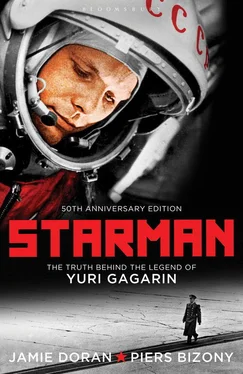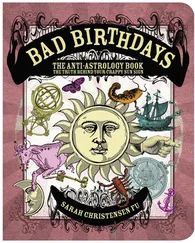Nikolai Kamanin instructed a sports official, Ivan Borisenko, to research the altitude-record regulations more deeply. By February 1961 the problem still had not been resolved. At this point, very late in the day, a strategic untruth seemed much more appealing than a major re-design of Vostok. Mazzhorin’s first envelope for TASS, containing the ‘successful’ announcement, falsely implied that the cosmonaut landed in his ship. ‘For a long time this legend was supported in all the official documents,’ says Mazzhorin. ‘Only in the glasnost era was the truth revealed to our people, and to the world.’ The other envelopes must have told a different story. For instance, if Vostok had landed over non-Soviet territory, the use of an ejection seat would have been blatantly obvious to foreigners. Mazzhorin cannot remember the precise wording he used, and he regrets the subsequent loss of his envelopes. ‘It’s a pity we destroyed them. They’d have a historic value today.’
Even the simplest details in the documents for TASS presented a challenge. In the lead-up to the first manned flight it seemed natural to call the capsule ‘Vostok-1’, in the expectation that others would follow in its wake; but the capsule’s principal designer, Oleg Ivanovsky, recalls, ‘If we’d given it a number, then it would have suggested that a series was beginning. We didn’t want anyone to know we were preparing other flights, so Vostok wasn’t given a number.’
A fourth and very different kind of document was prepared for stowage in the Vostok capsule itself. The cosmonauts were not to know it, but even in the last few weeks before the first manned flight, arguments were raging about the extent of command and control that a space pilot should be allowed during his mission. Everything centred around the mysterious six-digit keypad on Vostok’s left-side control panel.
So far, all space vehicles had been operated by on-board electronic systems linked by radio to control stations on the ground, which represented a difficult challenge in itself. What new problems might arise when a human pilot was included in the ship? The doctors worried that a solo cosmonaut might go mad up there, overcome by the spiritual and psychological separation from his companions on earth, while the security services worried that he might defect to the West, deliberately re-entering his craft over foreign territory at the end of his flight. By the autumn of 1960 the discussions about control underwent a bizarre shift of emphasis. The aim was no longer to give the pilot some dignified authority over his own vehicle, but to take it all away from him. Guidance of Vostok would be purely automatic, just as with all the unmanned ships. In an emergency, the crewman might be allowed to operate the controls for a while, but only if he could prove his sanity beforehand.
The engineers devised a six-digit keypad that would unlock the navigation systems from the computers and let the pilot steer his own ship, if manual control became necessary. He would be told the keypad combination only if the mission directors on the ground decided he was mentally fit for the job. With his accustomed logic, Sergei Korolev broke this plan down into its component parts and questioned the basic assumptions. Why would a pilot be given control of the ship? Presumably because the automatic systems had failed and he needed to take over. But if the ship started to tumble out of control, the radio link with earth might be interrupted just at the point when the pilot really needed to hear the secret code that would release his manual controls. The keypad idea seemed more dangerous than just leaving things be.
The doctors came up with a face-saving solution whereby the pilot could find out the code even if his radio went dead, as Vostok’s co-designer Oleg Ivanovsky explains: ‘They decided that if he reached for an envelope placed inside the cabin, ripped it open, took out the paper and read the number printed on it, then pressed the keypad, this careful sequence of actions would prove he hadn’t lost his mind and was still answerable for his actions. It was a dangerous comedy, part of the silly secrecy we had in those days.’ The whole procedure was self-defeating. Obviously the envelope had to be placed somewhere within reach in the cabin, and could not be hidden anywhere too hard to find, just in case the need for it was genuine and urgent. An unstable cosmonaut could have opened it at any time without permission and taken control of his ship. Mark Gallai, the Soviet Union’s Chief Test Pilot, was recruited into the space programme to help train the Vostok cosmonauts. In a recent interview with historian James Harford, he said:
All the test pilots believed these concerns were stupid. Many pilots had flown in the stratosphere at night, or in heavy cloud conditions… We made a great noise about the key panel. It was our feeling that the chance of a pilot going crazy was much smaller than the possibility of a failure in the radio communication… Korolev didn’t like the keypad either, but he decided to accept it to quiet the physicians… Suppose a cosmonaut made a mistake punching the buttons? Who would punish him? [6] Harford, Korolev , pp. 163–4.
Curiously enough, the American space pilots fought this battle in precise mirror-image. NASA’s cautious rocket engineers wanted fully automatic systems at first, but the astronauts insisted on a wide-ranging freedom of control. They took advantage of their high-profile appearances in Life magazine and on television to lobby for command over their own flights, or at least to obtain an equal partnership with their mission managers on the ground. Strong-willed, individualistic astronauts spent long hours throwing their weight around at the various aerospace factories, essentially designing many aspects of the emerging spacecraft to their own convenience.
There was no requirement to prepare any keypad codes or TASS envelopes for unmanned test flights of Vostok, nor to worry about rescue arrangements. If they descended over a foreign country, they could be destroyed by remote control with a 10-kilo explosive charge. If the ‘destruct’ radio command failed, an on-board timer would blow them up anyway, sixty-four hours after landing. This would discourage American rocket experts from looking into matters that did not concern them.
In fact, the early Vostok capsules needed little help destroying themselves. The first prototype, launched on May 15, 1960, spiralled out of control in space and was lost. Two dogs, Chaika and Lisichka, were put aboard another Vostok on July 28, after the capsule had been modified in the hope of improving it. Now came the R-7’s chance to disappoint its makers. Shortly after launch the rocket blew itself to pieces, dogs and all. The Vostok cosmonauts were at Baikonur that day on their first familiarization visit, and they witnessed the launch of the vehicle which, supposedly, was designed to carry them safely into space. Gherman Titov wryly recalls, ‘We saw how the rocket could fly. More important, we saw how it blows up.’
On August 19 two more dogs, Strelka and Belka, were sent into space. This time, much to Korolev’s relief, the R-7 settled into its climb and the mission proceeded smoothly. Both dogs made it safely back to the ground after seventeen orbits. There was much appreciation in the world’s press. Nikita Khrushchev was delighted. Privately, Korolev and the space doctors were disturbed by a small incident during the flight. Belka became dizzy with the weightlessness and vomited into the cabin. Did this mean that humans would also become ill up there? Cameras in the ship recorded the dogs’ demeanour throughout. Obviously the journey had not entertained them, but they seemed fine once they were back on the ground.
On September 19, 1960, Korolev formally submitted his proposal for a human flight, and the Central Committee of the Communist Party approved his request. Ten senior figures signed the documents: Korolev; his old ally, the mathematics and computer expert Mtislav Keldysh; the doomed, glory-seeking Chief of Missile Deployment, Marshal Nedelin; the Chief of Defence Marshal Ustinov; a watchful Valentin Glushko… If the new adventure was successful, that would mean glory all round. If there was any ‘unpleasantness’, then ten people could pass the buck. [7] Ibid., pp. 167–8.
Читать дальше












